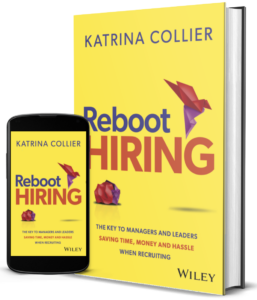(Ok, maybe not such) A very good place to start
But some backstory, to accompany the ear-worm. 🎶
It will help you understand what is going on right now in the minds of some of your leaders. And the more recruiters I talk to, who are on the verge of burnout, the more I hope this will help. 🤞🏻
Before the web irreversibly impacted recruitment
If you grew up with tech in your hand or the ability to Google just about anything, it can be difficult to understand the change older folks, like me, have had in our relatively short working careers.
If you’ve read my book, The Robot-Proof Recruiter, you might remember this story but in case not, back in 1992 when I got my first ‘proper’ job, there was no transparency.
I couldn’t pick up a smartphone and run a search, like you can today, for ‘recruiter jobs London’ and see 63 million results. The only jobs I could see were the few in the Sunday newspaper. I didn’t know how many jobs were really available. So people never left a job without securing another one first. And companies ruled with carrot or stick; be grateful you had a job, they would say. And well-being, and company perks, ha! What were they?
But along came the single biggest disruptor to the world of work.
The Internet. The creator of transparency, other possibilities, and the consumer-minded candidates and employees we see today.
In 2002 LinkedIn was founded, but it took the Great Recession of 2007/8 for people to really flood onto the network. Working in an agency, I soon realised that my little black book of contacts would soon be accessible to companies directly. Today, this is indeed the case.
Recruitment or talent acquisition readers, you probably come onto LinkedIn most days. You speak to candidates daily. You hear the shift in attitude of people – especially those possessing skills that are in demand. You understand that candidates and employees can have the power. Heck, now candidates can even ghost you back.
Sprinkle in a pandemic…
And the vast majority of workers received the opportunity for change. Lockdowns forced people to pause and reassess. Systems and processes previously considered immobile, were forced to be flexible.
People now want this flexibility. They want hybrid. They want choice. And their choice may not be your company or client’s company.
You know this.
But your leaders may not know this… not really know it!
A few months ago I delivered a candidate experience roundtable to a large group of senior HR Directors. During my pre-event due diligence, I realised that only one of the group had changed jobs in the previous 5 years. Only one person had recently experienced researching companies and jobs online.
Looking for a job has changed a lot in the last 5 to 10 years but do your leaders know that?
When did they last look for work? Do they know how easily information is available? Do they know how easy ‘Google for Jobs’ makes it to see jobs, reviews, and salary bands? Do they understand how people talk on the many review sites, on Twitter, and on the likes of Recruiting Hell on Reddit? Do they understand how damaging the ‘no feedback’ policy is?
As Executive Recruiter, Theresa Nordstrom, pointed out to me in yesterday’s Mastermind, maybe your direct hiring managers do understand this market but those they report to do not. And what about Comp & Bens, are they still using out of date data not what is available right there online (or from you!)?
And are your C suite listening to the media and governments, who want people back in the city to appease the rich landlords, rather than listening to their employees and candidates? People whose eyes have been opened to a world of possibility and are voting with their feet.
So what can you do?
You’ll remember I spoke about Talent Acquisition having a perception problem in my first article in this series, so try the following to bring visibility to your work and the issue.
- Walk your senior leaders through a job search. Show them just how much information is available. Show them the reviews (on all the sites, not just the one with the big marketing department!). Show them social channels. Open their eyes.
- Hit leaders with stats: “On this day in 2019 and 2020 we received this many applications, today we are receiving…”, ‘Here you can see I have approached this many people… this many responses” and so on.
- Speak “business” to them. “We lost this applicant due to multiple offers. If we’d offered just £2k more, we would have someone to deliver the project. Instead it’s costing us x”
- Conduct a competitor analysis. What information do they make readily available around purpose, hybrid/flexibility, DEIB, and salary. Yes, salary.
- If you are consistently losing people to your competitors, why is that? Gather stats. Do you know a recruiter in your competitor, can they share how being flexible or hybrid or diverse or… whatever… is helping them recruit? [Controversial suggestion, I know!]
- If you know your application process is unduly complicated: ask your C-suite to apply for a job at your company… on their phone! Let them experience the problem.
And final thought
When your hiring leader asks for yet more CVs, and you know that you have worked every angle possible to find someone and it simply won’t happen… reply politely with, “Yes, and can you help me do that?” and wait for their reply.
It might be indignant. It might be surprise. Hopefully, it’ll provoke thought and an open conversation about this candidate owned market.
Originally posted on LinkedIn as part of the Recruitment Isn’t Broken newsletter.

